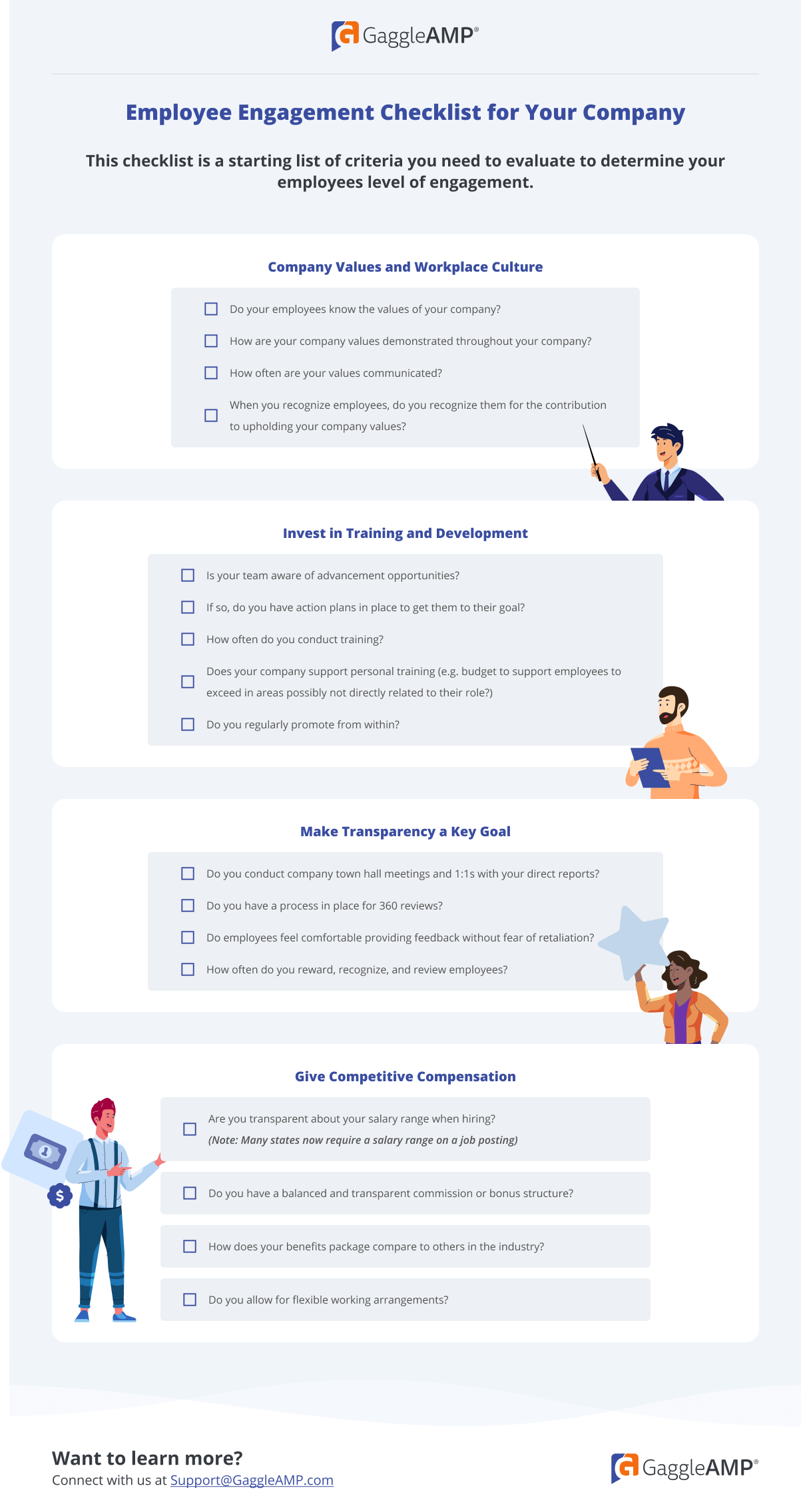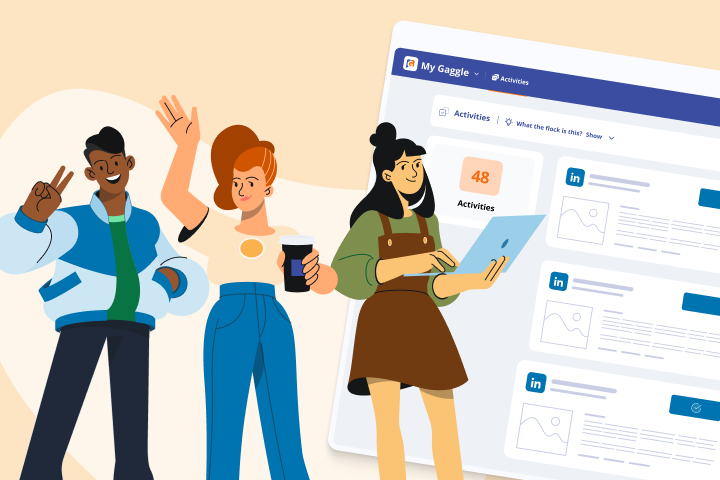How to Improve Engagement: A Practical Employee Checklist
Voluntary employee resignation has been at an all-time high. According to the Bureau of Labor Statistics (BLS), resignations peaked in March 2022, when a record 4.5 million employees left their jobs. This trend has continued since 2021 and is now being called ‘The Great Resignation’.
Clearly, this is a structural problem that cannot be solved by offering employees higher pay. Employees crave investment in the human aspects of work and need a purpose to stay committed to their career objectives. From the company's perspective, the cost of rehiring employees can be massive.

According to the Society for Human Resource Management (SHRM), hiring a new employee costs nearly $4,700 on average. But, consider soft costs, like the opportunity costs of hiring. The total cost per hire can be a whopping three to four times the position’s salary.
That said, it’s important to keep your employees engaged to ensure lower attrition.
Broadly defined, employee engagement refers to the connection employees have with their employer. It gauges how committed employees are to their workplace and work. Employees who care profoundly about their jobs and go beyond what is expected are considered highly engaged employees. We’ve put together an employee engagement checklist that helps you take steps to ensure you’re on the right path.
Why Is Employee Engagement Important?
Employees are a critical component of your business. Their daily operations, decisions, and commitment can have huge impacts on your business’ performance.
Engaged employees are usually:
- Faithful in the company’s vision and management.
- Have a deep connection to their work.
- Desire personal growth and learning.
- Regularly deliver beyond what is expected of them.
It is essential to measure employee engagement to know what and how you need to improve.
Employee engagement cannot be built overnight. Follow some of the best practices to get started and work towards it.
Engaged employees lead to better business outcomes than average or disengaged employees. They are more productive and less likely to quit their jobs. This saves you from spending thousands of dollars and lots of additional time on rehiring employees.
According to research by Gallup, only 15% of employees worldwide and 35% in the U.S. are engaged. For example, compare the top and bottom companies for employee engagement. The top companies saw an 81% reduction in those missing work. They also boast an 18% increase in productivity as compared to companies at the bottom.
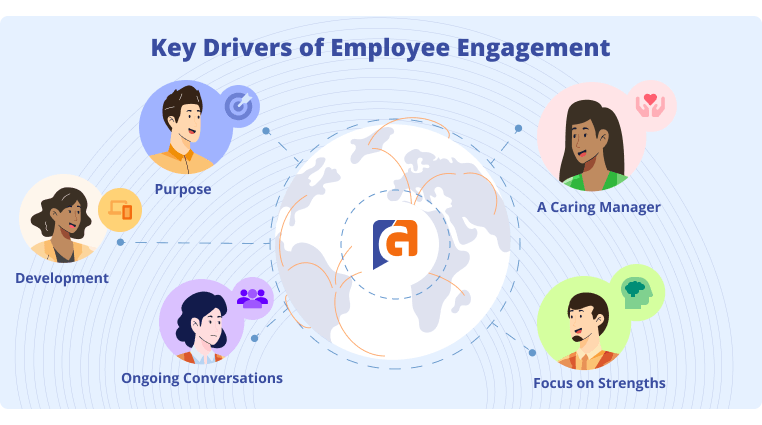
Now let's take a look at the key components of employee engagement.
What Are the Key Components of Employee Engagement?
To create a truly engaged workforce, there are eight key components of employee engagement your brand needs:
-
Leadership. Establishing strong leadership will help build trust between employees and their managers. When employees don’t trust management, that can result in lack of motivation and poor performance.
-
Communication. Providing transparent communication will foster trust and inclusion, making employees feel more connected to your brand and its mission.
-
Culture. Cultivating a positive culture not only results in a happy workforce, but it improves retention and customer satisfaction as well.
-
Rewards and Recognition. Offering formal recognition or rewards to employees for a job well done goes a long way towards driving engagement and productivity.
-
Professional and Personal Growth. Giving the opportunity to strengthen existing skills and gain new ones is crucial for keeping employees engaged. Provide mentorship opportunities, workshops, and courses to help your employees grow.
-
Accountability and Performance. Providing honest (and timely) feedback is essential for employee engagement and growth. Be sure to give praise when it’s due, and offer constructive criticism when it’s needed.
-
Vision and Values. Communicating your brand’s vision and values to employees will help them understand how they fit into your company’s big picture. When employees feel aligned with a mission and feel a part of something bigger, that will translate into higher engagement.
- Corporate Social Responsibility. Using your brand to contribute to the well-being of society (or a specific community) shows your employees that their contributions are going towards a good cause. Not only does this boost employee engagement, morale, and loyalty, it resonates with current and potential customers, too.
How To Measure the Success of Employee Engagement
To ensure your employee engagement efforts are working, you need to measure them. Here are six ways to measure the success of your employee engagement initiatives.
-
Engagement Surveys. Use surveys to collect real-time actionable feedback. Pulse surveys, in particular, are a convenient and efficient way to collect employee responses. Typical questions to include in your pulse survey are satisfaction, opportunity, and alignment questions.
-
Employee Net Promoter Score (eNPS). eNPS is a scoring system that employers use to track and measure employee engagement. Your eNPS is based on a single question asked to employees. For example, “On a scale from 0-10, how likely are you to stay with this company for five years or more?” The eNPS score is calculated based on the difference between the highest and lowest response (e.g., your most-engaged employees and least-engaged employees).
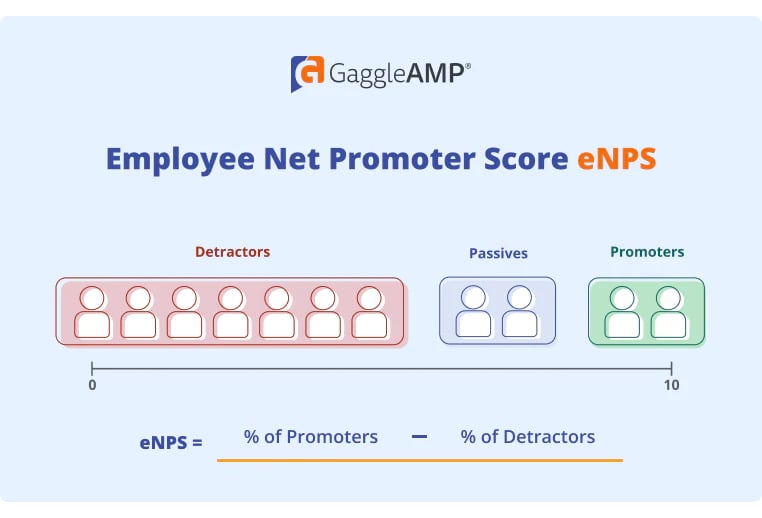
-
One-on-Ones. These individual meetings can be conducted in-person or virtual, and are helpful for asking detailed questions and gauging responses based on verbal and non-verbal cues. An example of a question that you could ask is, “What is your favorite part about working for this company?” Pay special attention to what they say (or don’t say).
-
Stay Interviews. These one-on-one interviews allow you to pick the brains of your long-term employees. You can ask them what has kept them from leaving, giving you insight into what areas of your company are working, and what areas could be improved.
-
Employee Retention Rates. The goal is to have a high-retention rate since it equates to an engaged and happy workforce. To calculate your employee retention rate, use this formula: Retention rate = Total no. of employees in the organization- No. of employees who quit in a given period / total no. of employees x 100.
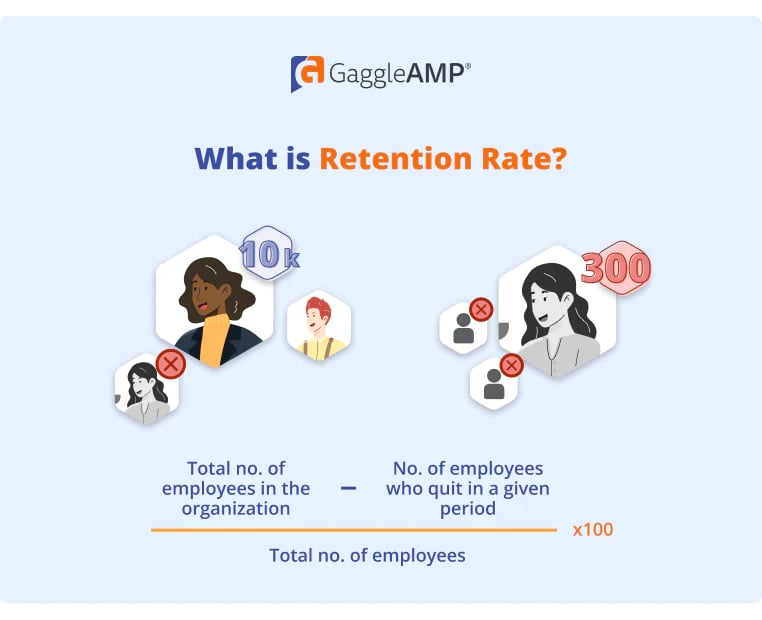
-
Employee Productivity Rates. Employee productivity is how much output a company produces per input. To calculate your employee productivity rate, use this formula: Productivity rate = Outputs/Inputs. Depending on the product or service, it might be hard to quantify especially if it’s intellectual work. So, if it’s intellectual, replace the output with dollars.
A Manager’s Employee Engagement Checklist
Employee engagement is a steady and gradual process. You have to invest in it regularly to reap its benefits. When you think about fostering employee development, consider the following factors.
Company Values and Workplace Culture
When you focus on your core values and create a robust workplace culture, employees are more likely to stay engaged. When you align what your employees do with what they value, you’re investing in employee engagement.
For example, say your mission statement is to be the market leader in your niche. Your employees might not be able to relate to it. They need an emotional connection to achieve the level of employee engagement you’re hoping for.
However, think about what happens when you make your mission to have an impact that is larger than your business. For example, Airbnb’s mission is to “create a world where you can belong anywhere.” With a mission like this, your employees are able to relate to it and stay engaged.
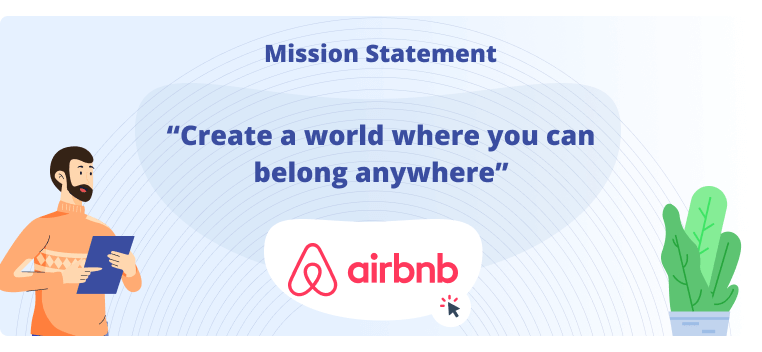
Additionally, don’t remain too generic about your corporate values. Translate them into specific behaviors that are actually implementable at an everyday level. For example, if you value teamwork, integrity, and accountability, create a list of guidelines and actions that can foster those values. This simple method has been shown to increase employee engagement by 107%.
Invest in Training and Development
You must ensure that your employees feel like there are opportunities for growth and that their career has not stagnated. This involves training and development sessions, which are especially important in technical roles, to keep your employees competitive. This is also a way of demonstrating to employees that your company is invested in their career progression and career goals.
Training and development build your employees’ confidence, which is a crucial driver of employee engagement. Other methods include allowing workers more flexibility and autonomy to discover their interests. This fosters their intrinsic employee motivation and increases their sense of confidence.
Make Transparency a Key Goal
If you want to achieve the values discussed above, think of transparency as a method to achieve it. Employees like you involve them in decisions. Take their feedback and concerns seriously and they’re more likely to stay engaged and committed to your organization. Transparency also involves recognizing people’s valuable contributions and acknowledging them accordingly.
The best way to improve transparency is to keep communication channels open. Use a feedback tool, have check-ins, and hold company huddles. More than 60% of Glassdoor users said their perception of a company improves after seeing an employer respond to a review.
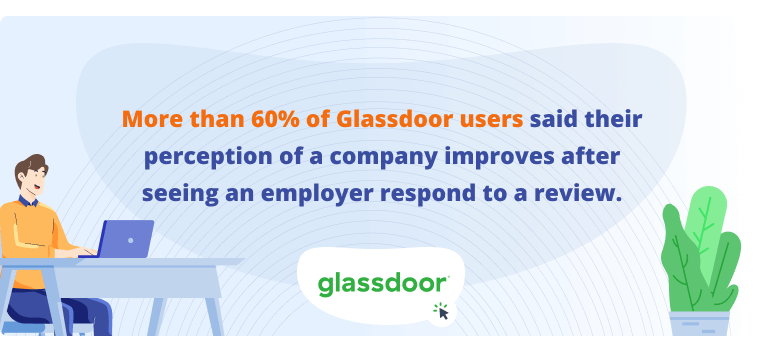
Give Competitive Compensation
Competitive compensation should be a bare minimum. Then, other more cerebral aspects of engagement can be met.
If your employees are worried about financial obligations and sub-par pay, which diminishes the quality of their lives, they’re likely to be disengaged employees. They’re also more likely to quit if they get better offers elsewhere. Therefore, make sure your employees have financial security, allowing them to focus on other ways of engagement.
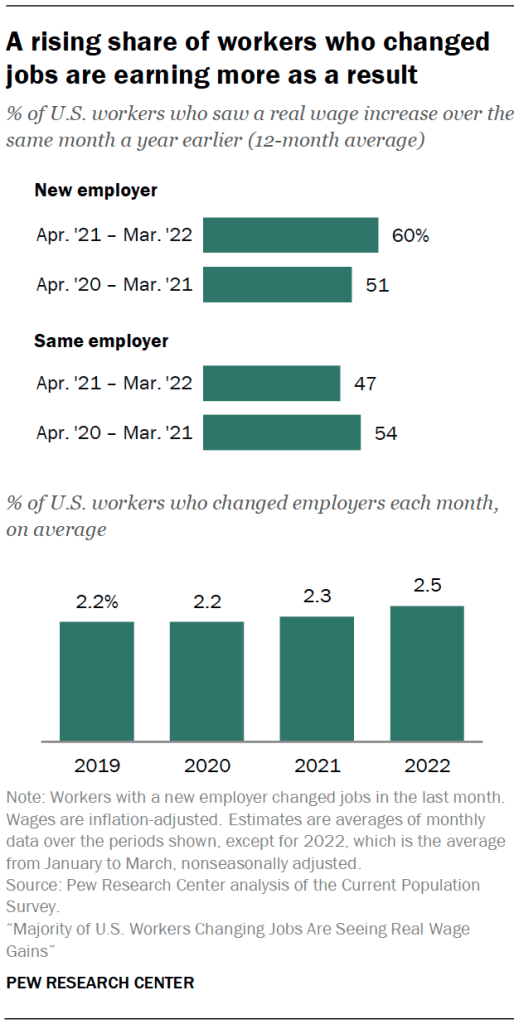
Source: Majority of U.S. Workers Changing Jobs Are Seeing Real Wage Gains
We’ve broadly discussed an employee engagement checklist to drive employee engagement. There are also many activities that you can conduct to boost employee engagement. With GaggleAMP’s employee advocacy platform, employees share content with their network. This helps increase their reach, driving engagement for both them and your company.
Your employees can perform over 50 different activities on platforms such as LinkedIn, X, Facebook, Instagram, TikTok, and more. We also provide in-depth analytics and dashboards to help you keep track of your program. Check out how our employee advocacy platform has helped some leading businesses and get started with yours.
